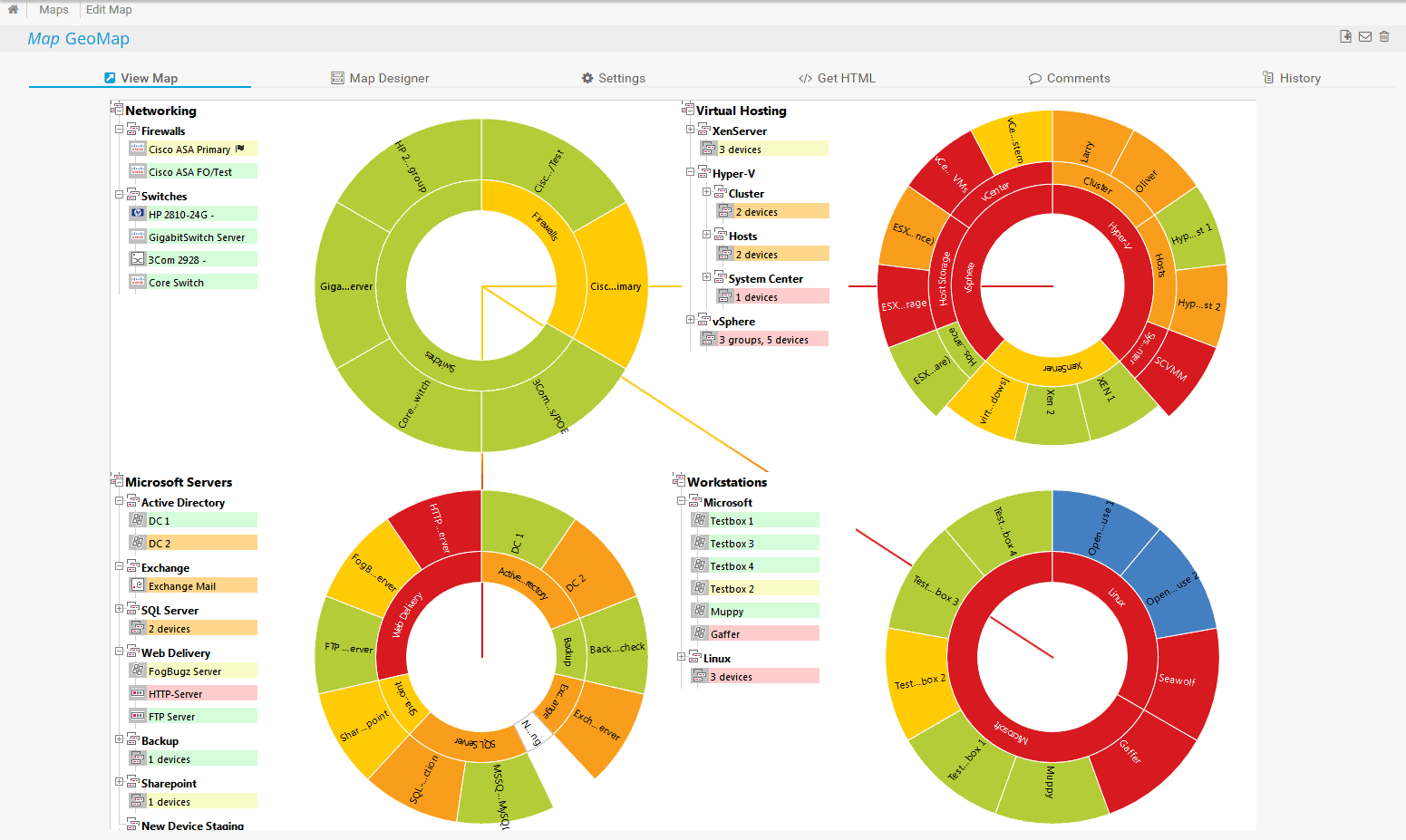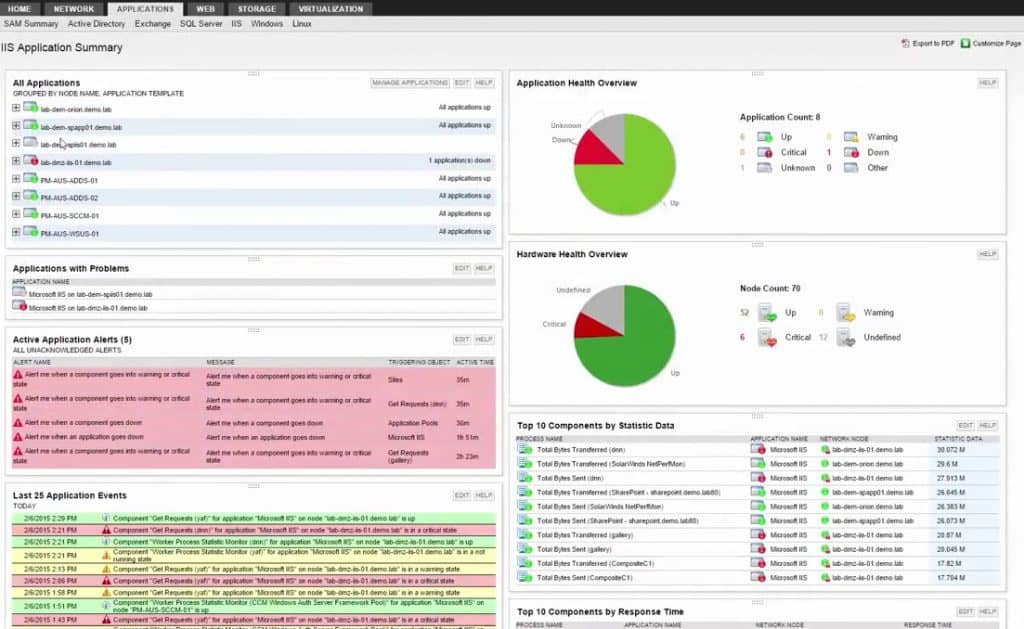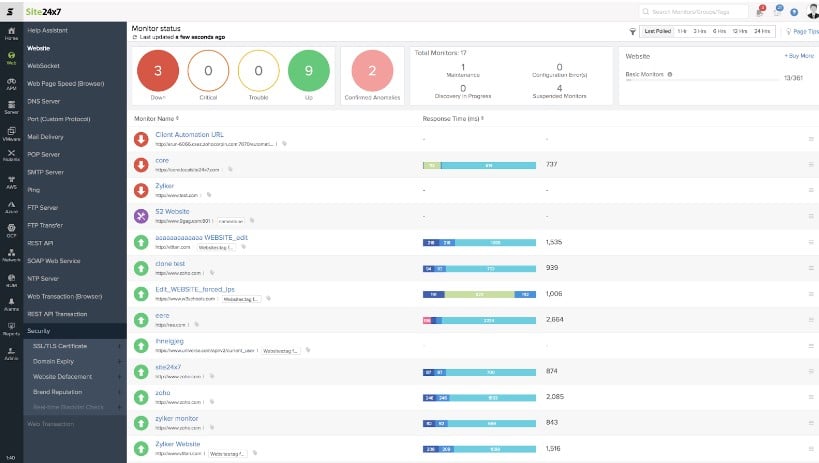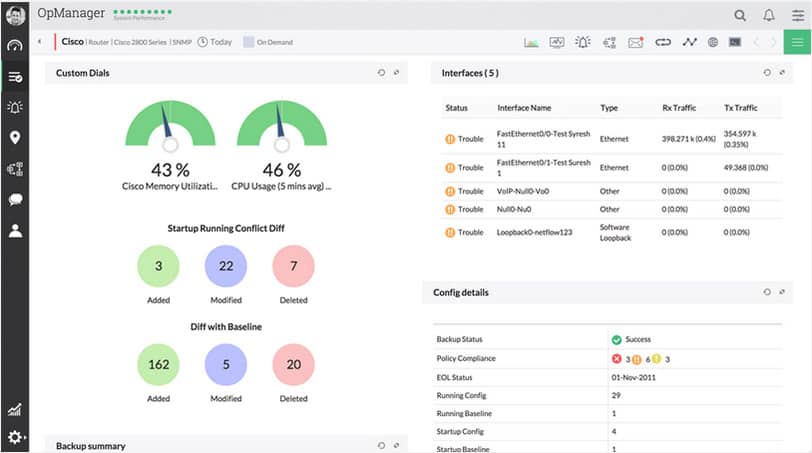Our funding comes from our readers, and we may earn a commission if you make a purchase through the links on our website.
The Best Nagios Alternatives for Server, Application and Network Monitoring
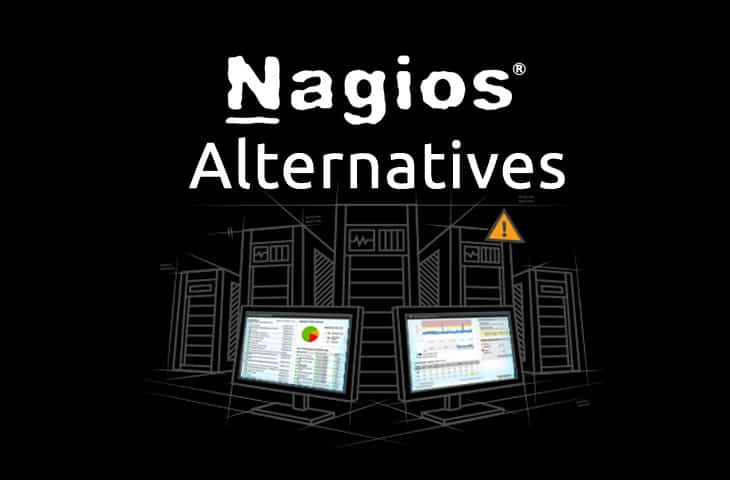
UPDATED: October 17, 2023
Nagios is a great tool for Server and Application monitoring and keeping an eye on your infrastructure and organization. For being Open Source and widely available for multiple operating systems, Nagios can sometimes have its limitations compared to other commercially available options.
We'll discuss some of the best Nagios Alternatives for server and network monitoring for your infrastructure, along with some in-place replacements that make it seamless to migrate.
Here is our list of the top Nagios Alternatives:
- Paessler PRTG – EDITOR'S CHOICE This full-stack monitoring package goes a little further than Nagios because it includes bandwidth analysis, which Nagios has split off into a separate package. Available for Windows Server or as a SaaS package. Get a 30-day free trial.
- SolarWinds Server & Application Monitor – FREE TRIAL This monitoring package traces the performance of applications, services, and servers, and links their operations together so it can spot gathering problems with resource shortages. Installs on Windows Server. Start a 30-day free trial.
- Site24x7 – FREE TRIAL This cloud platform offers packages of system monitors that provide network, server, application, and Web asset monitoring services and also log collection. Access the 30-day free trial.
- ManageEngine OpManager – FREE TRIAL A network monitoring package that covers physical and virtual systems. Available for Windows Server and Linux. Get a 30-day free trial.
- Progress WhatsUp Gold A network performance monitor that can be expanded by add-ons to monitor servers and applications as well. Runs on Windows Server.
- Zabbix A free monitoring package that watches over networks, servers, and applications and is a close rival to Nagios Core. Runs on Linux.
- OpenNMS A useful, free network monitoring package that can be expanded by plugins. Offered in free and paid versions, this system runs on Linux.
Common issues that have arisen from folks using Nagios are things such as Auto-discovery of services and applications being used without additional configuration and add-on's being thrown into the mix.
Gartner even had an article on the matter than went into some detail about why folks should get rid of it altogether and look for a better supported software, in case your “talented engineer” decides to leave the company, you won't have a mess on your hands trying to figure out how to upgrade and config a Nagios instance.
Regardless of why your looking for an alternative to Nagios, we've detailed a list of the best network monitoring software that can replace Nagios in your environment. Some of these are Free, others are Paid and commercially supported, which we highly recommend in any production environment. We've been in many situations where having a support contract has saved us hours on end in troubleshooting and misconfiguration of the software.
The Best Alternatives to Nagios
Our methodology for selecting a Nagios alternative
We reviewed the market for server, application, and network monitoring tools like Nagios and analyzed options based on the following criteria:
- Full stack monitoring with live data collection
- Performance monitoring that collects device activity information for network devices and endpoints
- Time-series graphs that show recent performance
- Root cause analysis that links together performance with resource availability
- Alerts for performance problems
- A free trial for a risk-free assessment opportunity or free tool
- Value for money from a paid tool that provides full monitoring capabilities at a reasonable price or a free tool that is worth using
With these selection criteria in mind, we identified a range of system monitoring tools that fully rival Nagios XI and also free systems that match or beat Nagios Core.
This is a quick list of Server and Application monitoring software that can be used in place of Nagios in your environment.
1. Paessler PRTG – FREE TRIAL
Paessler PRTG is another fairly familiar software package in the server and application monitoring world with its flexible offerings in terms of capabilities and functionality. PRTG has a nice graphical user interface and is fairly easy to use when it comes to getting setup and moving fairly quickly.
Some Main features of PRTG:
- Customizable and Flexible interface
- Flexible Alerting System
- Distributed Monitoring Capability
- Network Maps and more…
PRTG Does Not have the Nagios script Import feature that SolarWinds has but has a nice Template system and Auto Discovery system that will allow you to setup devices in an easy manner.
Pros:
- Drag and drop editor makes it easy to build custom views and reports
- Supports a wide range of alert mediums such as SMS, email, and third-party integrations into platforms like Slack
- Supports a freeware version
Cons:
- Is a very comprehensive platform with many features and moving parts that require time to learn
PRTG contends nicely with the others from above, but as mentioned above, lacks the native functionality to import Nagios scripts into the Program. Check out more about PRTG at their official site and learn about their full Feature Set there. You can start of by downloading a 30-day free trial from their site.
EDITOR'S CHOICE
Paessler PRTG is our top pick for a Nagios alternative because it matches Nagios on all of its functions, such as network discovery inventory management, and network mapping. The network monitoring features in PRTG exceed those in the Nagios XI and Nagios Core packages because this system includes bandwidth analysis, which Nagios has placed in a separate package, requiring another purchase. This system can monitor servers, cloud platforms, services, and software as well as networks, just like Nagios. If you only activate 100 sensors in PRTG, the package is free forever.
Download: Get the full package on a 30-day free trial
Official Site: https://www.paessler.com/download/prtg-download
OS: Windows Server or cloud
2. SolarWinds Server & Application Monitor – FREE TRIAL
We've gone through several of manufacturers and come to the conclusion that SolarWinds Server & Application Monitor is in the Top Tier for alternatives in this case. SolarWinds Server & Application Monitor has a full array of Features that really stands in terms of capabilities when looking for an enterprise platform.
Features of SAM include the following (via solarwinds.com):
- Automatic Discovery of Applications in your Environment
- Pre-packaged Alerts and Reports which are Easily customizable
- Agent or Agent-less Monitoring, per your requirements.
- Customizable Built-in Templates and direct Import of Nagios Scripts (200+ Pre-built templates)
- Server Capacity/Volume Monitoring and Planning
- Customizable Dashboard
- USE Existing Nagios Scripts and Import to Start Monitoring Within Several Minutes!
Main Reason SolarWinds takes the Best choice for Nagios replacements is there EASY Nagios Script Import feature that allows you migrate all scripts from your Nagios server over to SolarWinds very quickly with their import feature – This allows you to be up and Running within Minutes, not Hours!
On top of all the features, bell's and whistles that comes with the software, the enterprise support is there to assist with any issues that arise during setup or maintenance.
SolarWinds Server & Application Monitor covers all layers of digital infrastructure on premises and will also monitor cloud-based systems. Drill down from user-facing software through all of the supporting applications, such as Web servers and access rights managers down to the server and its resources to see where problems might arise. The tool creates dependency maps between running processes and applies machine learning to predict where performance problems might occur.
Pros:
- Designed with large and enterprise networks in mind
- Has some of the best alerting features that balance effectiveness with ease of use
- Supports both SNMP monitoring as well as packet analysis, giving you more control over monitoring than similar tools
- Uses drag and drop widgets to customize the look and feel of the dashboard
- Robust reporting system with pre-configured compliance templates
Cons:
- This is a feature-rich enterprise tool, small networks may find it overwhelming
Download a Free 30-day Trial and Get it setup on a VM in 15 mins
3. Site24x7 – FREE TRIAL
Site24x7 is a cloud platform, so you don’t have to download and host a software package to run this package of monitoring systems. Instead, you access the dashboard through any standard Web browser. The system setup process will download an agent program onto one of your servers, then you get all of the activity of your IT assets uploaded for analysis at the Site24x7 server.
Site24x7 is offered in bundles of tools that include:
- Network device monitoring
- Bandwidth analyzer
- Server monitoring
- Application performance monitoring
- Real-user monitoring for websites
- Synthetic monitoring for websites
- Automated performance alerting
Nagios can be extended by plug-ins and Site24x7 has a similar system. Activating an extension adds on extra screens and probes to the system to monitor specific technologies, such as an Oracle database or an Apache Web server. IT is even possible to write your own plugins.
The monitor will automatically discover all of the devices connected to your network. It creates a network inventory and a network topology map. While monitoring is ongoing, the Site24x7 system rechecks and updates its inventory and map if changes have occurred.
Pros:
- Flexible cloud-based monitoring option
- Offers a host of out-of-box monitoring options and dashboard templates for SQL server
- Allows administrators to view dependencies within the application stack, good for building SLAs and optimizing uptime
- Offers root cause analysis enhanced by AI to fix technical issues faster
- Can unify SQL monitoring across multi-cloud environments
Cons:
- Site24x7 is a feature-rich platform with options that extended beyond databases management, may require time to learn all options and features
This system is available for a 30-day free trial.
4. ManageEngine OpManager – FREE TRIAL
ManageEngine OpManager is another choice for switching out an open-source software and moving to a commercial grade software. As we've mentioned about in the SolarWinds description, one of the main issues we have is getting proper support and not having to install several other applications in order to do the job of what 1 installation should do.
ManageEngine has the following features:
- Network & Server monitoring capabilites
- Bandwidth usage and analysis
- Firewall event log management
- and Much more
We did not see anything on their Site in regards to importing Nagios scripts and this could prove to be cumbersome when trying to migrate over. SolarWinds still has the advantage over OpManager in this regards, but if you would like to read a detailed review of ManageEngine OpManager, you can see it Here!
Pros:
- Can monitor bandwidth consumption as well as alert to configuration changes that could impact network performance
- Can monitor bandwidth and resource consumption on the application level, and even drill down to identify specific users consuming the most resources
- Supports email, SMS, and webhook for numerous alerting channels
- Integrates well in the ManageEngine ecosystem with their other products
Cons:
- Takes time to full explore the all the options available in the ManageEngine software suite
See more information and start a 30-day free trial.
5. Progress WhatsUp Gold
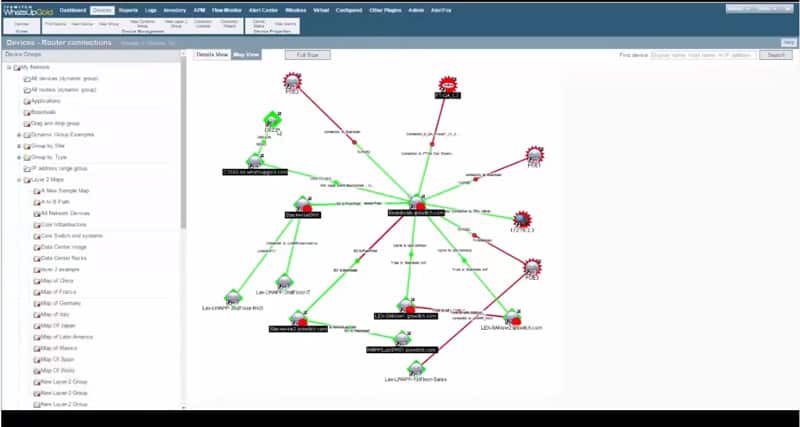
WhatsUp Gold is another main competitor and replacement for Nagios as a server and application monitoring solution. WhatsUp Gold has some nice features and functionality that will prove to be useful in any environment.
The new interface for WhatsUp Gold 2017 has a very simple, uncluttered layout if that's what your looking for. We prefer a more detailed dashboard, but some like very simple and modern dashboards with multiple tabs for other screens.
Some of the Main features include:
- Automated Discovery
- Network Traffic Analysis and Monitoring
- VM Overviews and Monitoring capabilites
- Application & Server Performance Monitoring
We dug around to see if we could find some information in regards to importing or converting existing Nagios scripts into WhatsUp Gold, but could not find anything on this package either.
Take a look at their official website for more information and details;
Download WhatsUp Gold Today and Give it a Test Drive:
https://www.ipswitch.com/forms/free-trials/whatsup-gold
We've highlighted Several good Nagios alternatives along with Screenshots and Feature sets. In our eyes, Solarwinds Server and Application Monitor is the clear winner due to its Native Nagios Script Import functionality which really helps you get the Monitoring system migrated over Very quickly – even within Minutes!
Pros:
- Great interface
- Supports a wide range of flow-enabled devices
- Can support both virtual and physical hardware
- Balances user experience with monitoring features quite well
Cons:
- Only available for Windows operating systems
- Free version can only monitor up to five resources
With a 30 Day Free Trial and their Support channels and User forums, they've really taken the necessary steps to set themselves apart from their Competitors.
Open-Source
These are a few of the nagios alternatives that seem to be fitting for Paid solution, there are also an abundance of Open-source replacements that make moving away from nagios less painful and potentially cheaper.
6. Zabbix
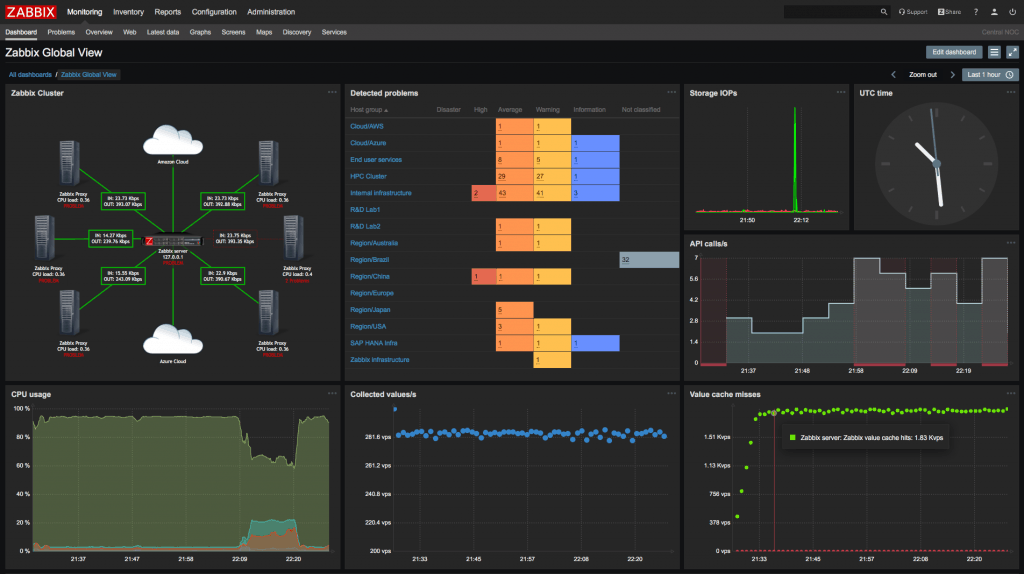
Zabbix is a Great solution if your looking for an open-source alternative. They have really been stepping up their game lately and their interface has changed so much over the years that its worth looking into.
Features that Zabbix now includes:
- Multiple Platform agent for monitoring different systems
- SNMP & IPMI Monitoring Agents
- Agentless monitoring of user services
- Custom methods for Collecting Dadta
- Aggregation & Calculation of Metrics/Data
- End user Web monitoring & New UI
Pros:
- Open-source transparent tool
- Uses both SNMP and ICMP for broader monitoring ranges
- Offers useful templates for quick insights
Cons:
- No paid support option – not ideal for large enterprise environments
7. OpenNMS
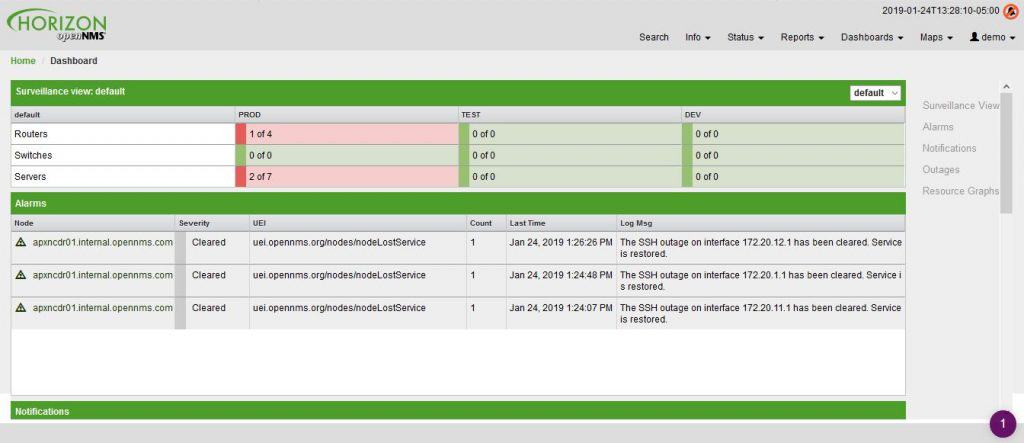
OpenNMS is another great open-source monitoring tool that really stands out from the other open-source competitors as they have partnered with some larger companies to ensure intergration and support is as seemless as possible.
They also support a wide variety of monitoring solutions and system including some of the following:
- Citrix XenApp
- Apache with the HTTP collector
- Asterisk (PBX)
- exim
- GDataAntiVir Services
- Microsoft AD Services
- Microsoft Exchange
- Microsoft Standard Services
- Microsoft Windows Remote Desktop Session Host servers
- Microsoft Windows Update Services (WSUS) servers
- MySQL
- MySQL with the HTTP collector
- Nginx with the HTTP collector
- PostgreSQL OpenNMS DB
- Symantec Backup Exec
- VMware Tools
- MSSQL
- Tomcat 5.5 JMX How-To
Pros:
- Open source projects, lots of room for customization, and personalized add-ons
- Has a large amount of documentation available
- Features two versions, a stable version and a beta test version for new features
- Offers a wide range of monitoring options and flexible alert notifications
Cons:
- Users rely on help documents and forums for support, which isn’t always the quickest way to resolve issues
Nagios Alternatives FAQs
Is Nagios the best monitoring tool?
Nagios is a very strong system monitoring package but its ability to compete in both the free and paid system monitoring market is frequently challenged. The free tool is very comprehensive. However, the Nagios team has taken away the traffic analysis functions from this, moving them off into a separate paid tool, which puts Nagios Core at a disadvantage when compared to other free system monitors. Nagios XI is only available for Linux, which puts it at a disadvantage when competing for sales because many businesses are Windows-only and so would need to run the Nagios monitoring system over a hypervisor. Probably the biggest threat to Nagios’s market share is the movement of the major rival systems to the Cloud – a move that Nagios isn’t making. The major strength of Nagios lies in the large library of free plug-ins that are provided by Nagios Exchange.
Which is better Nagios vs zabbix?
Zabbix is a very strong competitor to Nagios and its development is very encouraging. Zabbix is completely free to use, which makes it a competitor to Nagios Core. Zabbix beats Nagios in the free monitoring market because it has a good frontend, which Nagios Core lacks and it also provides NetFlow monitoring, which isn’t present in Nagios Core – that is a separate paid module with Nagios. Nagios XI is a more comprehensive package than Zabbix. However, comparing a paid tool with one that is a free tool, you would expect better functionality from a system that earns money.
Is Nagios obsolete?
Nagios covers both the free and paid monitoring system markets and it has a very loyal user community. The concept of this tool being obsolete is probably generated by the rivals of the monitoring package rather than its users.

